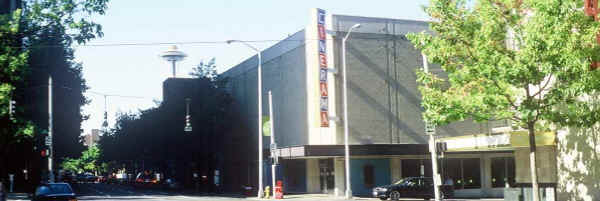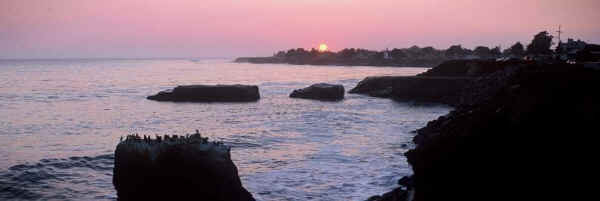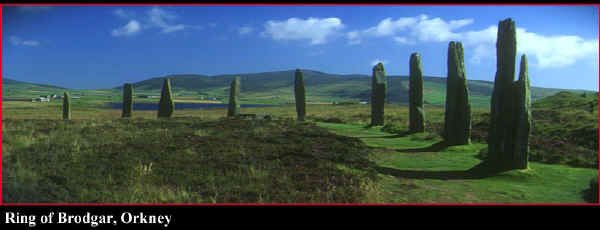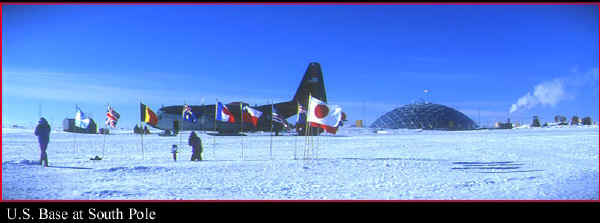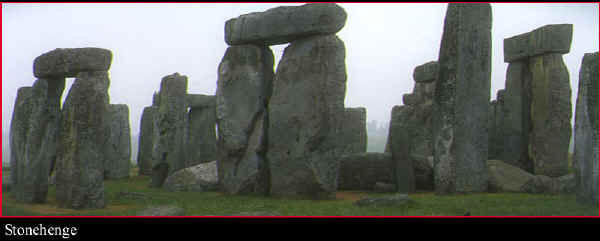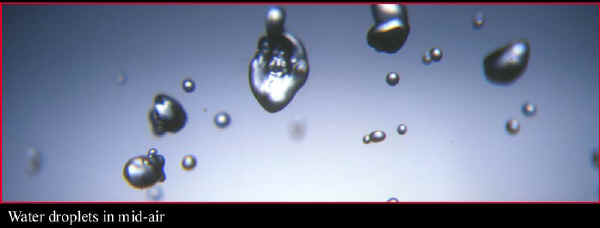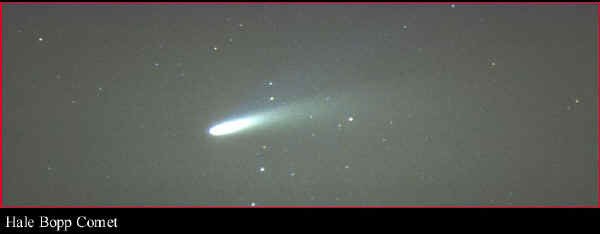![]()
Wide Screen Movies Magazine
edited by John
Hayes
Issue 2
by John Hayes
A couple of years ago, at the Widescreen Weekend - an annual event which is part of the Bradford Film Festival - I was fortunate enough to attend a demonstration screening of a new widescreen process. Several of us were curious as to what could be actually "new" in the widescreen field; we had seen all the systems that had come and gone at one time or another, so we were not prepared to be easily impressed. So you can image the gasps of amazement when, as the red velvet curtains slowly pulled back to reveal the huge curve of the Cinerama screen, an image appeared that was so wide, it spilled off the edges of the screen and on to the side walls of the auditorium! VISTAMORPH had arrived.
Vistamorph is a 70mm widescreen process that has been developed by the Glasgow-based company, Vistatech, which was founded by Chris O'Kane and Richard McKelvie to provide panoramic still photographs for commercial and industrial use. Using a x 2 compression anamorphic lens on a standard 35mm film, they were able to produce spectacular images with a 3 : 1 aspect ratio, several of which we have reproduced here.
It soon occurred to them that this method of producing wide images might also be applied to motion pictures, as a means of creating extra-wide pictures on 70mm film. They decided to obtain a VistaVision camera, on which they mounted their anamorphic lens. The VistaVision system moves 35 mm film horizontally through the camera, rather than vertically, as in a conventional camera; and it also uses an 8 perf. (film perforations - sprocket holes) frame - twice the size of the normal 4 perf. - much the same as a standard SLR still camera, and giving an aspect ratio of 1.5 : 1. This is, in fact, very similar to the old Technirama system ( but with greater anamorphic compression). But where Vistamorph diverges from Technirama is in the transfer from 35mm negative to 70mm print. Technirama "unsqueezed" the 8 perf. image in the optical printer and produced a spherical print 5 perfs high on 70mm film, which was compatible with Todd-AO and the later Super Panavision . Vistamorph, on the other hand, retains the anamorphic compression and transfers it directly to the 70mm print, as in the illustration here. This results in a mind-blowing 3 : 1 aspect ratio on the screen, when projected through an anamorphic attachment on the projector.
The Vistamorph system was used to produce the demonstration film we saw at Bradford. It was calledA Trip To Dunoon, and was simply comprised of a series of shots of a ferryboat journey. This mundane subject took on a truly jaw-dropping quality with the width and clarity of the screen image. One could only imagine how spectacular this system would look if it were used to present a special effects-laden space fantasy or costume epic. Hopefully, someday soon, some producer will realise the potential of the sheer visual power contained in the giant, Cinerama-like, Vistamorph system, and create just such a movie.
IMAX…eat your heart out!
And now for the interview . . .
Chris: Vistatech Ltd was formed in 1998 as a specialist photographic company to develop Vistamorph photography for commercial markets. The name Vistamorph came from a combination of a Vista and anamorphic. Thus Vistamorph. For several years we undertook assignments, mainly from architects, photographing landscapes where projects are to be built. Surprisingly we were asked very often to photograph scale models which could be projected as massive panoramas. Initially we did not think this would work very well but the results were pretty good. We also undertook standard and large format photography assignments.
John: What prompted the decision to move towards motion pictures?
Chris: The decision to move to motion picture came about while we were at the Cannes Film Festival in 1997. We were doing a panoramic Scotland show as a support to the premier of Mrs. Brown. One of the companies we bumped into was The Magic Camera Company based at Shepperton Studios. They informed us that they shot quite a bit of VistaVision format for spfx plates etc. I was not aware that anyone was still shooting this format, but I knew it would match up with our Vistamorph concept. So early in 1999 I paid a visit to The Magic Camera Co. and we did a test shoot on one of their old Fries VV cameras. The weather was very poor and the light was dull. We shot at f4.00 on 250asa daylight neg. It was Kodak's new Vision stock. I was surprised when we saw the result. We lost no light through the lens and the colour was still there.
John: Can you tell us about Vistamorph's development?
Chris:
Vistamorph came out of my interest in Cinerama and widescreen cinema.
I saw 2001 when I was ten years old at the Coliseum here in Glasgow.
It really made an impression on me. I just love the composition of wide
screen. So in later life, when I started working with film, I coupled
up an anamorphic with a Bolex and shot 16mm scope films of vintage aircraft
for future archive material. I did this for about 15 years and enjoyed
it immensely. But it became far too expensive to do just for fun, so I
looked at ways of photographing on 35mm still slide film. I suppose the
whole Vistamorph format came together in my mind while I was visiting
the Jet Propulsion Lab in Pasadena California. I went for a tour of the
facility and at the end the guide sat us in the Von Karman auditorium
and arranged to show us a multi-slide wide screen presentation which would
take us on a tour of the Solar System. At first they couldn't get the
machines to sync up and when it was running it was obvious that the panoramic
images did not match up too well. These types of slide shows are great
fun when everything is serviced properly and it all works. After the show
my curiosity got the better of me, so I went back stage and took a look
at the equipment set up they were using. 12 35mm slide projectors, 3 Apple
Mac computers, control boxes and cables everywhere. It dawned on me; they
were throwing too much technology at the problem. We've all seen split
screen effects in 60's cinema, we've all seen Woodstock! The answer
was to use anamorphic optics to present a one-piece panorama. I wondered
why no one had done it before, so when I got back to Scotland I experimented
with many lenses and cameras before I found a combination that works.
The idea was simple enough, capture a wide panoramic view in one go and
project it to a large scale in one go. Thus was born Vistamorph.
Several years
later of course we graduated to shooting 2x anamorphic full frame VistaVision.
Working with Technicolor I thought we might be able to use existing 2x
anamorphic decompression optics in printing VV neg to 70mm 5 perf. This
is not possible due to the large size of the VV neg area so we had to
figure a way to do it which would produce a 70mm print which could be
projected without special optics. The answer was to print the whole VV
frame to the middle of the 70mm frame and mask out the void spaces at
the sides of the frame in the print. Of course this means preserving the
2x squeezed image onto 70mm, but it was found to be easy to project this
large anamorphic frame with existing lenses in large cinemas. Even better
in Cinerama and Todd AO theatres
So Vistamorph Motion Picture was born and it is now a UK registered trademark. We pursued a patent application but we were unsuccessful, the European Patent Examiner upheld that it was novel, had industrial application, but that it contained no inventive step. So in the end I think this is a good thing. It means there is no patent on the format, it can be used by anyone worldwide without legal restrictions. This is what the industry needs, there's no point in making a format that is so tied to a company that you have to sign your life away to use it. My hope is that it will inspire filmmakers to pick it up and use it. Right now we have a design for a new anamorphic lens that will allow us to shoot a 90 deg. standard eye view. All being well the prototype will be manufactured this year. BUT………It all depends on someone backing the format, the idea, the concept, the movies, the theatres etc. I.E. Do they have the balls and the vision to try it? The industry needs something like Vistamorph right now; large formats are not getting any cheaper.
John: What kind of reception has Vistamorph received?
Chris: To date we have demonstrated 70mm Vistamorph to a few groups of people within the industry. Our first demo took place at the ABC Sauchiehall Street. The number 2 cinema was opened in 1967 and was the last purpose built Todd AO theatre in Europe, or so I am informed by the man who designed and built it, Richard Norton. Mr. Norton was among the audience for the first demo and among his many achievements was the design and build of Elstree Studios. Richard was a big help in getting Vistamorph going. It is very reassuring to have people who have spent a lifetime in the industry and who have achieved so much, tell me that Vistamorph does work and I'm on the right track. We also ran a quick impromptu test at the Seattle Cinerama after the big event for the Seattle Film Festival. It was 1.00am and everyone was exhausted, few people stayed that late, but some of the Cinerama team was around. The projection team very kindly ran a new test film. Vistamorph is a 3 to 1 aspect ratio so it did not fit the Cinerama screen exactly, in fact, it spilled off the edges by quite a few feet. The Seattle Cinerama screen is a louvred screen and it's 96ft wide. Vistamorph must have been over 100ft wide. It's the biggest test we've done. I gauge the quality by walking toward the screen until I can see the grain. At 10ft I could perceive the individual grain. That's a BIG picture for your money. We also ran the test film at the Bradford Widescreen weekend on a reduced scale to fit it on the screen. Tony Cutts spoke to me about fixing up a temporary screen sometime so we could get a full-scale view. I hope to run the test film at the Cinerama Dome in LA in January. The response by people who see it is good and supportive, but it's the old problem, who's going to back it?
We don't have a venue to show the format yet. We tried to save the ABC Glasgow for it, but the powers that be and big bucks won the day. It's now a pub and nightclub. There's damn all vision in Glasgow I'm afraid. I was pushing a team at the Royal Scottish Museum for a film and TV museum for Scotland. A plan had been floated before, but this fell down on running costs. A new plan is apparently afloat and I've said I'll only get involved if they build it around Vistamorph. The Vistamorph concept fits in with commercial cinema. The auditorium is designed to show all formats from Vistamorph to 70mm, 35mm 16mm and digital. Variable masking does the trick on a curved screen sheet.
John: Would it require a louvered screen, similar to the old Cinerama ones?
Chris: I understand that there is a company in Europe that manufacture a non-bounce material which is canvas-backed and does not bulge in the way that the old screens did. This could be the answer to many problems if this is true. We did approach Futuroscope Film Park in France last year but they said they would keep us on file for future plans. I hope to find someone in Hollywood who could champion the cause.
John: Would 35mm reduction prints be viable?
Chris: Although Vistamorph is shot in VV format it can be reduced to 35mm for conventional cinema screening, but the ratio will still be 3 to 1. So if you make a good film in Vistamorph it can still be shown in any cinema in the world. It's the Technirama process really.
John: When I saw Vistamorph a couple of years ago, I remember it as being distortion-free. Was distortion something you struggled to overcome?
Chris: The concept of Vistamorph photography is to capture a wide field of view in panoramic form without the typical wide-angle spherical distortion you get with current still lenses. No lens is distortion free and the concept is to keep the horizon view accurate and not pushed away into a fish bowl effect. Our new lens design has a distortion of 3.5% across the field. That's not too bad. It's always a difficult thing to keep away from when you design an anamorphic. Most distortion is at the sides of the image, that's where all the optical demons live. Vistamorph looks good on a curved screen mainly I think it's because the image is formed through a combination of spherical and cylindrical optics. It's projected back in much the same set up onto a cylindrical screen. That's perhaps why it looks distortion free. But remember no lens is distortion free. IT depends upon the viewer's interpretation. Vistamorph also works well on large flat screens too.
John: Is depth-of-field much of a problem?
Chris: Working in anamorphic is fun and challenging. There are rules you have to obey when composing for the format. Depth of field and depth of focus both have some limitations you don't get with prime spherical optics. So you have to work with it and compose shots with this in mind. What has been surprising is just what you can get away with. We have some still anamorphic shots of water droplets in mid air. The field of view in that shot is only 3 inches wide.
John: Does the system require a similar depth of curve of screen as Cinerama?
Chris: On projection Vistamorph is quite tolerant of flat and curved screens. It can be shown on Cinerama type curves as we have seen, but the screen does not have to be that deep a curve. But we have designed the process to fit in with most common formats so it will be a compromise on shape somewhere along the line. It's much like Super Cinerama screens. Both 35 and Todd AO fit the screen but there is some distortion. I've never heard the public complain about it. It would be great to get it all as near distortion free as possible, but this is all to do with how much money you want to spend on it.
John: I would have thought that the moderately rectangular image shape on the 70mm film would have helped light distribution on the screen. Has this been the case?
Chris: One thing that is attractive about the projection is that you use only the hot spot of the lamp and reflector system. It's surprising how even the light distribution is across the picture. Not using the light drop off in the corners of the full 70mm frame is a help.
John: What do you see as the ideal future for Vistamorph?
Chris: What would our ideal future be for Vistamorph? Well personally I would like to see it all over the world in every city with people queuing around the block and me being a multi-millionaire living on a paradise island. Knowing the history of this industry it is most likely that I will die in obscurity and poverty after having being beaten and abused by the great powers that be, while film fans will say "It's the way he would have wanted it". But before all of that I expect to have a damn good time making Vistamorph movies. Well, to be honest, it's not going to be easy. But there is a market for second world countries and museums and science centres and theme parks, where they require to entertain and educate an audience for 40 minutes but they don't have 10million bucks for Imax and can't afford to run it anyway. Vistamorph has a massive potential in second world countries. 800 million cinemagoers paying $1.00 a head represents a lot of business. The trick is convincing investors that you have the right product, the right marketing and the right team to make it all happen. This is what Cinerama did in the 50's and 60's and I think they should do it all over again in the 21st Century. In the end I believe a good idea is a good idea, no matter what. Vistamorph is a form of photography in its own right.
I'd like to take this opportunity
to thank Chris for his time and patience with this interview, and for
supplying the excellent Vistamorph pictures for the article. I would also
like to wish the very best of luck to Chris and the Vistamorph team in
Glasgow, and hope that they have every success with the remarkable Vistamorph
system.
J.H.
